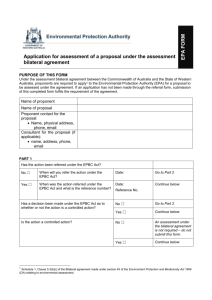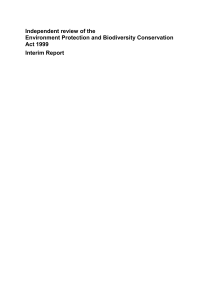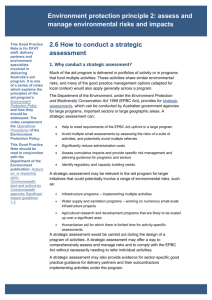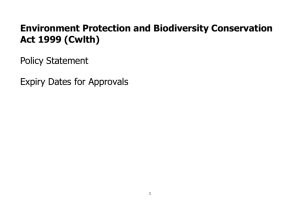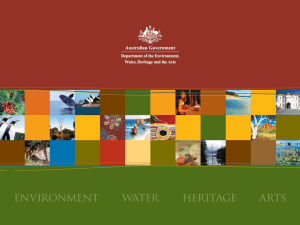Environment Protection and Biodiversity Conservation Act 1999
advertisement
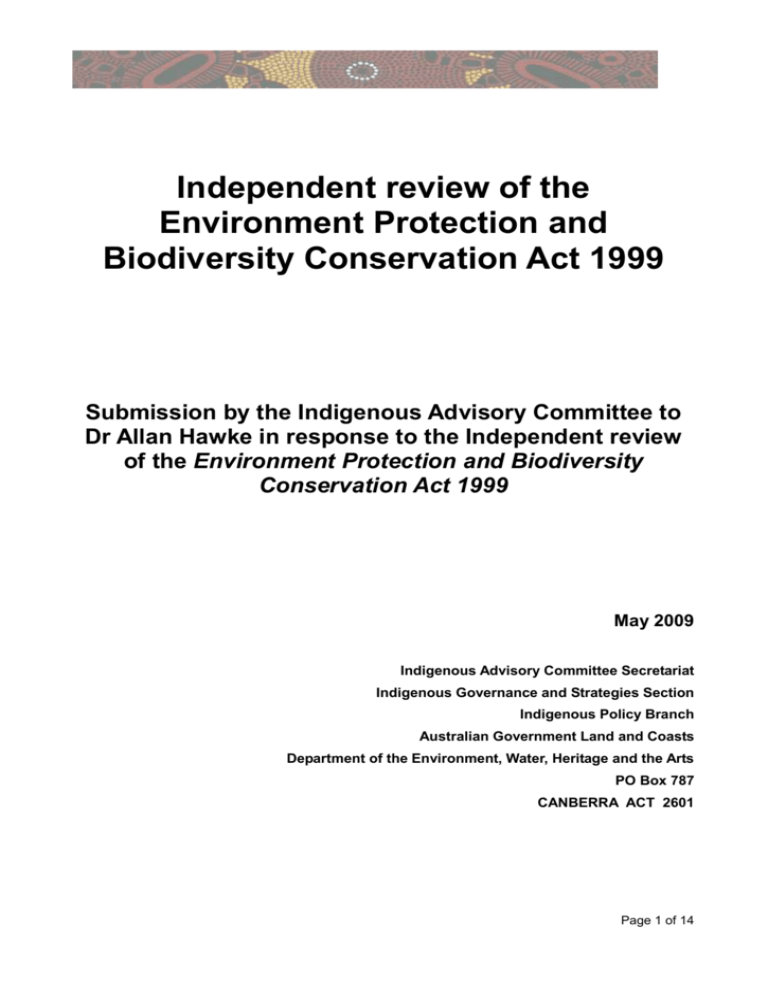
Independent review of the Environment Protection and Biodiversity Conservation Act 1999 Submission by the Indigenous Advisory Committee to Dr Allan Hawke in response to the Independent review of the Environment Protection and Biodiversity Conservation Act 1999 May 2009 Indigenous Advisory Committee Secretariat Indigenous Governance and Strategies Section Indigenous Policy Branch Australian Government Land and Coasts Department of the Environment, Water, Heritage and the Arts PO Box 787 CANBERRA ACT 2601 Page 1 of 14 Introduction 1. The Indigenous Advisory Committee (IAC) was established in 2000 under the Environment Protection and Biodiversity Conservation Act 1999 (EPBC Act). The IAC advises the Minister for the Environment, Heritage and the Arts on the operation of the EPBC Act, taking into account the significance of Indigenous peoples' knowledge of the management of land and the conservation and sustainable use of biodiversity. The IAC also provides an advisory role on Indigenous Protected Areas. 2. The IAC is made up of members who are Indigenous Australians who have been selected on the basis of their expertise in Indigenous land management, conservation and cultural heritage management. The members of the IAC have a wide range of skills and knowledge in the fields of park management, Indigenous land and sea country management, health, tertiary education and local, regional and state Indigenous affairs. 3. The IAC addresses issues relating to the EPBC Act including issues relating to activities in Commonwealth areas and activities affecting the matters of National Environmental Significance that the EPBC Act covers. These are currently World Heritage properties, Ramsar wetlands, nationally threatened species and ecological communities, migratory species, Commonwealth marine areas, nuclear actions including uranium mining, and places on the National Heritage List. 4. The IAC also has a broader function, providing advice to the Department on the development and implementation of policies and programs that may impact upon Indigenous people. Further more the committee advises on appropriate methodologies for engaging and consulting with Indigenous Australians. 5. The IAC acknowledges that Section 552A of the EPBC Act requires an independent review to be undertaken within 10 years of the commencement of the EPBC Act. 6. The IAC makes this submission to Dr Allan Hawke in response to the Independent review of the EPBC Act. 7. The IAC acknowledges and thanks Dr Allan Hawke and his review team for their participation in our meeting held on 17 March 2009, which provided a valuable opportunity for the IAC members to discuss their views on the operation of the EPBC Act. 8. We also thank Sheryl Hedges, Kathleen Mackie, Robert Mills and Alycia Muir for their work in supporting IAC members in the development of this submission. Scope of the EPBC Act Q1 What are your views on the scope of the EPBC Act as they relate to Indigenous issues. Q1.1 Are the objectives meeting Indigenous needs (why not?) Q1.2 How do you see the EPBC Act meeting Indigenous needs in the future? Page 2 of 14 Q1.3 How would you like the EPBC Act assessed to ensure Indigenous needs are being met? 9. The objects of the EPBC Act seek to promote an active role for Aboriginal and Torres Strait Islander peoples in the protection and management of the environment – the establishment of the IAC is one important example. Regrettably, the objects of the EPBC Act still fall well short of the aspirations of Indigenous Australians. If it is going to genuinely meet the needs of Indigenous peoples in the future, the objects of the EPBC Act needs to enhance the level of respect and regard than is currently provided for. 10. The EPBC Act provides the foundation for a broad legal and policy framework for the conservation and management of Australia’s environment and heritage. Not only does the EPBC Act need to provide appropriate and comprehensive safeguards, it must also set and apply standards and processes mindful of Australia’s international obligations, the autonomy and responsibilities of the States and the rights and responsibilities of a wide range of stakeholders. 11. The IAC is mindful of the very broad scope of the EPBC Act and the range of advantages and disadvantages arising out of this approach. It is the view of the IAC that this approach, while providing for some good outcomes, has largely failed Indigenous Australian’s aspirations for the protection and management of our heritage and environments. 12. The broad scope of the EPBC Act, combined with the need for a holistic policy approach to environmental management and conservation gives rise to the need for a broad level of engagement by and with Indigenous Australians. The IAC acknowledges the efforts made to effectively engage Aboriginal and Torres Strait Islander peoples through this legal and policy framework, however, its broad scope still allows for too many inconsistent processes and ad hoc outcomes. Sadly, too many Indigenous heritage sites have been destroyed or suffered irreparable damage as a result. 13. Ultimately, the capacity of the EPBC Act to meet Indigenous rights, interests and aspirations in the future is a matter of political will for both the Parliament and the Executive. Until such time as both parliamentarians and bureaucrats see the benefits of recognising and supporting Indigenous rights, interests and aspirations, it is difficult to imagine that this framework will meet the needs of Aboriginal and Torres Strait Islander peoples. The rights and interests of other more influential stakeholders will continue to attract the priority attention to the detriment of Indigenous Australians. 14. For example, the promotion of a ‘co-operative approach’ needs to be mindful of the special relationship that Indigenous peoples have with their environments. The Parliament must accept that this special relationship gives rise to a suite of rights and responsibilities that apply to Indigenous Australians irrespective of the EPBC Act, its objects, standards and functions. The opportunity is now available to the Parliament to upgrade and improve the EPBC Act, not only to give due respect and regard to Indigenous peoples rights, interests and aspirations, but to also improve the overall assessment, protection and management outcomes. Page 3 of 14 15. Without wanting to limit the rights and responsibilities of the States, the IAC also believes that the EPBC Act needs to take primacy over the standards for environment and heritage protection in all jurisdictions. Not only should the EPBC Act provide a mechanism through which Indigenous peoples can seek protection of their heritage and environments, it should also set a standard for the engagement of Indigenous peoples that is consistent across all states and territories. The IAC suggests that Indigenous heritage places are made a matter of National Environmental Significance (NES). It has great potential to remove uncertainty and have Indigenous heritage addressed very early in any referral process. 16. Ideally, consideration needs to be given to the undertaking of a separate review that combines analysis of the Aboriginal and Torres Strait Islander Heritage Protection Act (ATSIHP Act) with the EPBC Act. 17. The ATSIHP Act needs to be revised to include a minimum set of standards consistent with those in the revised EPBC Act to deal with Indigenous heritage (places and objects) at Commonwealth level below the NES level. The ATSIHP Act has assisted some Indigenous people through non ‘last resort’ means, namely that developers are forced to negotiate with them, and that they are included in the consultation process whereas before they may not have been included. 18. Criteria ‘I’ of the current EPBC Act needs to be amended and state/territory bilateral agreements should incorporate protections of all Indigenous heritage places on their heritage lists to meet the Commonwealth standard. This would mean that the ATSIHP Act could be amalgamated into the EPBC smoothly. More importantly for Indigenous people and the Australian Government at least, there would be one piece of legislation which deals with Indigenous heritage adequately and that there would be automatic protection for all Indigenous heritage places right up front before any development begins. The threshold for Indigenous National or Commonwealth listing would be continue to be the same of being outstanding, uncommon, rare, potential to yield information contributing to better understanding, its importance in demonstrating a class of cultural places or environments, aesthetic characteristics, high degree of creative or technical achievement, special association with a particular community or cultural group, and special association with the life or works of a person – criterion a to h – with the threshold of “the place has outstanding heritage value to the nation”. 19. The creation of separate Indigenous environment and heritage protection legislation may not provide the best approach to addressing the EPBC Act’s shortfalls, but it is an option that should at the very least be investigated. 20. Serious consideration needs to be given to Indigenous Australians having their own specific section within the EPBC Act. Alternatively, every Section needs to outline how Indigenous Peoples are engaged in the processors of the EPBC Act, not relegated to a few pages here and there. History has demonstrated that this leads to exclusion of processors. There is a restrained Indigenous capacity to respond to ever-increasing demands for IAC role and members. Page 4 of 14 21. We would recommend that the following be investigated and answered as part of the review: Is the EPBC Act the appropriate mechanism? What has changed since the EPBC Act was introduced? Is the EPBC Act meeting the proposed intentions of the EPBC Act? With Climate Change and water being an evolving issue, what mechanisms will be put in place to incorporate these and other emerging issues, particularly those of interest to Indigenous people? Assessment and Approvals Q2 Does the public understand their responsibilities under the EPBC Act to refer proposed actions to the Minister? Q3 Are appropriate projects being referred for approval? Does the referral process meet the objects of the EPBC Act? Q4 Do you think that the EPBC Act contains an effective hierarchy of environmental assessment approaches, ranging from assessment on referral information to assessment by public inquiry? Are the methods of assessment providing the required information for informed approval decisions? Q5 Does the EPBC Act provide appropriate scope for public participation and transparency in the assessment and approval process under the EPBC Act? Q6 Does the EPBC Act operate effectively in conjunction with State and Territory planning and environmental impact legislation? Are existing bilateral agreements achieving the objects of the EPBC Act? Q7 Are there further opportunities to harmonise the EPBC Act with other State and Territory legislation, planning and approval processes? Q8 Does the use of strategic approaches, such as strategic assessments and bioregional plans, provide opportunities for streamlining Commonwealth involvement in environmental issues? Do such approaches provide an appropriate means for dealing with cumulative impacts? 22. Since the abolition of the Aboriginal and Torres Strait Islander Commission and the introduction of new arrangements for service delivery to Indigenous communities a paradigm has arisen with respect to government policy approaches. Sadly this approach tends to dismiss Indigenous peoples rights, interests and aspirations for their environments, culture and heritage in favour of more mainstream outcomes in areas such as health, education and employment. All too often the assessment processes tend to disregard the broader socio-economic benefits arising out of Indigenous peoples effective management of their environments, culture and heritage. 23. There is a need for the Australian Government to develop minimum standards for dealing with Indigenous heritage places. Page 5 of 14 24. The EPBC Act needs to encourage the Department to incorporate complete cultural landscapes and environments, as determined by appropriate Indigenous groups, when making assessments and decisions. For example Deen Maar Island was not listed as part of the Budj Bim National Heritage Landscape. 25. An effective mechanism needs to be developed within the EPBC Act so that Indigenous interests are engaged and their values for certain places are recognised, when assessments and approvals take place. 26. The EPBC Act provides mechanisms to make decisions around development where there is no evidence base to suggest that particular developments may impact on sites of significance, in many instances of International significance, to sway the decision on development approvals. For example, the short comings in the approval for expansion of the development on the Burrup Peninsula. This point is reiterated in Kakadu and Ranger/Jabiluka mine. Of course a lot of these processes are politically charged, particularly when they involve the powerful mining sector. We are heartened with the engagement and consultation process undertaken in the EPBC Act Assessment of the proposed Kimberley Gas hub but note that such consultation was taken as a will of the previous WA government, rather than as a legislative requirement. 27. The process for National and World Heritage listing needs to be more clearly defined in the EPBC Act, to ensure that those organisations representing the interests of Traditional Owners are fully engaged and undertake processes associated with these listings. 28. There needs to be proper consideration given to the management arrangements of newly declared National and World Heritage processors. The opportunity for the Minister to declare Special Management Areas (Section 316, Subdivision 316) must be investigated for new areas being considered under each of these lists. 29. The interests of Indigenous peoples must be engrained within the process of establishing and the content of state/federal Bilateral Agreements. 30. Bioregional planning is seen to be undertaken in isolation with Traditional Owners, especially for Sea Country. Engagement with Traditional Owners is generally last minute and ad hoc. 31. The IAC has requested information pertaining to the approvals process from the Department, however, the lack of response highlights that the system works for the majority and not the minority. 32. We would recommend that the following be investigated and answered as part of the review: Will places listed on the Register of the National Estate (RNE) be automatically transferred to the NHL? The IAC are concerned about the Page 6 of 14 protection of places listed on the RNE when it comes to referral and approvals. Biodiversity Q9 Does the EPBC Act provide an effective regulatory framework for the conservation of Australia’s biodiversity? If not, what improvements could be made? Q10 What are your views on the process for nominating threatened species, ecological communities and key threatening processes? Q11 Given the length of time required for the assessment of nominations, should the EPBC Act allow for the emergency listing of species and ecological communities which may be threatened (similar to the provisions for the emergency listing of National Heritage places)? Would the advantages of this be outweighed by the financial and administrative costs? Q12 What matters should the Minister consider when deciding whether to list a threatened species or ecological community? Q13 Are the categories of threat appropriate? Q14 Are there opportunities to reduce duplication between the Commonwealth and State and Territory listing regimes or do overlaps between the regimes provide significant protection for threatened species and ecological communities? Q15 What factors should be considered in setting priorities for recovery planning? Q16 Does the planning regime support the effective recovery of threatened species and ecological communities? Q17 Are there opportunities to improve the co-ordination between the Commonwealth and State and Territory recovery regimes? If so, what might these be? Q18 Are the provisions of the EPBC Act for the protection and recovery of threatened species and ecological communities, migratory species, listed marine species and cetaceans effective? What alternative approaches might be available? Q19 Does the EPBC Act provide an appropriate legislative framework for addressing climate change and other emerging pressures in the context of environmental protection and biodiversity conservation? If not, how can such matters be considered when making decisions under the EPBC Act? 33. The IAC considers that proper processes for consultation and negotiation with Indigenous peoples needs to be written into the EPBC Act particularly where there is potential for the listing of species of wildlife considered to be potentially threatened or endangered. The current arrangement where state/territory jurisdictions are responsible for consultation with Indigenous peoples is failing to provide for effective processes or outcomes. It is our view that establishing a process that is applied consistently across all jurisdictions is of paramount importance. 34. The incorporation of these initiatives will assist in building the necessary relationships to enable the provision of advice and assistance in the arising planning, recovery and Page 7 of 14 management strategies. Where there are specific conservation reserves and conservation zones, direct arrangements between Indigenous groups and the Australian Government should be made to support the direction of the arising management opportunities. 35. While such management arrangements need to be based on a recognition of Indigenous peoples rights, interests and aspirations, they still provide the opportunity to meaningfully engage Indigenous peoples through such as the monitoring of species populations. For example, Part 13 of the EPBC Act provides capacity for the incorporation of a regulatory framework around hunting. The principles of such a framework must recognise that management responsibility needs to lie with the users of the resource. To be effective this does of course need to be backed by adequate financial and other resources to ensure that traditional management/regulatory practices are observed. 36. IAC members believe that there needs to be some thought around seeking a process of identifying and listing plants of significance to Indigenous peoples primarily used for medicinal and cultural uses (botanical and common name only – not Traditional Knowledge). This would be a pre-emptive and proactive approach by the Australian Government, as the plants would be afforded protection before their numbers are threatened. It is envisioned that this list would be in addition to the threatened and endangered species list. 37. The definitions of biodiversity must include the role that Indigenous Australians play in this arena and should recognise our continued stewardship role. Protected Areas Q25 What factors should the Minister have regard to when making a decision on heritage listing? Q26 What are your views on the process for nominating and listing Commonwealth Heritage and National Heritage places? Q27 What are your views on the effectiveness and utility of Commonwealth heritage strategies and management plans for protecting World, National and Commonwealth Heritage values? Q28 Given that the protection and conservation of Australia’s heritage is shared between the different levels of government, are there any improvements in the current legislative arrangements that would be of benefit? Q29 What are your views on the effectiveness of the operation of the provisions for Ramsar wetlands and the utility of management plans for those wetlands? Q30 What are your views on the effectiveness of the operation of the provisions for Commonwealth Reserves and the utility of management plans for those reserves? 38. The EPBC Act by nature does not afford opportunities for Indigenous Communities to be directly involved in the preparation of management plans for Commonwealth Page 8 of 14 reserves. Appropriate changes need to be made so that this responsibility can be devolved to the appropriate organisations that represent relevant Indigenous groups. 39. A common feature of the processes for the assessment of protected areas where nomination has occurred on the basis of Indigenous heritage values is that they are often subject to dispute by other stakeholders. Rather than acknowledge the contribution that Indigenous heritage provides for the National Estate all too often Indigenous peoples have to be subject to criticism about how our interests are impacting on or holding back much needed economic activity. 40. As much as any group in Australian society, Indigenous peoples have considerable need for economic development opportunities. Such opportunities must not, however, be allowed to undermine recognition of the cultural and spiritual attachment that Indigenous peoples have with their lands. 41. The process for adding environments and cultural landscapes to the National Reserve needs to be more responsive and expedient. The IAC recommends that the cost of acquisitions should be met entirely by the Commonwealth. Indigenous Involvement Q31 Are there opportunities to harmonise legislative provisions for the protection of indigenous heritage values? If so, how? Q32 Does the EPBC Act adequately support Indigenous involvement in the preparation of management plans for Commonwealth reserves? If not, what improvements could be made? Q33 Do the processes under the EPBC Act facilitate the involvement and cooperation of Indigenous people as owners of knowledge of biodiversity? Q34 Does the EPBC Act make adequate provision for Indigenous tradition to be taken into account in decisions made under the EPBC Act? 42. Section 49A(c) of the EPBC requires that consideration be given to ‘the role and interests of indigenous peoples in promoting the conservation and ecologically sustainable use of natural resources in the context of the proposed agreement ...’. The IAC is concerned that this requirement is insufficient. Firstly, it requires no engagement with Indigenous peoples in determining the ‘role and interests’. Secondly, it is a very limited provision considering the scope of Indigenous peoples interests and the evolving recognition of our rights and aspirations. 43. The EPBC Act is heavily influenced by political whims, not based on Indigenous cultural or other connections to country (recent McArthur River process). 44. There may be a need for separate Indigenous Advisory Committees for the different components of the EPBC Act. Page 9 of 14 45. We would like to see a need for mandatory Indigenous engagement instead of the current passive engagement. 46. Consideration for discussion needs to be what are the deliverables of the EPBC Act, what do Indigenous people want to be able to go back to governments (Australian and state/territories) to assess what has/hasn’t been delivered. 47. Assessment of the protection mechanisms provided for under the EPBC Act requires both a qualitative and quantitative analysis of the outcomes that have affected Indigenous Australians since the EPBC Act came into operation. Ideally, such an analysis should be undertaken in concert with the review of the ATSIHP Act. 48. An opportunity is still available within the current review of EPBC Act to undertake at least a preliminary assessment. It is the view of the IAC that such an assessment should consider (among other things): a. The number of places protected and rejected as a result of nominations for Indigenous heritage values; b. The number of places with high Indigenous heritage values that have been damaged or destroyed since the commencement of the EPBC Act; c. The level of consideration given to Indigenous values where a nomination for heritage protection has been made on the basis of other values; d. The level of engagement of Indigenous peoples in the development of management plans for protected areas; and e. The contribution of Indigenous peoples in decision-making process for the nomination of protected areas. 49. As we have referred to above, the differing classifications for heritage protection that are applied across the various jurisdictions is problematic and provides for no real protection for Indigenous Australians at all. Rather than provide for the cooperative approach this situation too often places Indigenous Australians at odds with state governments and other stakeholders. Rather than work together with a common objective, too often Indigenous Australians seek to utilise the protection mechanisms provided for under the EPBC Act in competition with their respective state governments. 50. In order to address this situation the IAC is of the view that the EPBC Act needs to set a standard for the assessment, protection and management of all potential and actual protected areas as they affect the rights, interests and aspirations of Indigenous peoples. While states may have the opportunity to improve on those standards they should not be permitted to fall below them. Such standards should be applied irrespective of whether state or federal legal frameworks are being used for given protected areas. 51. Indigenous traditions are only taken into account through the decision making process but the EPBC Act needs to be strengthen to ensure Indigenous traditions are amongst the deciding factors. Page 10 of 14 52. The EPBC Act needs to cross reference with Section 93 of the Native Title Act to engage Prescribed Body Corporates (PBC) for referrals, consultation, advice and decisions, and needs to promote resources to PBCs to build capacity and empower Native Title Holder groups to participate. 53. Is there provision in the EPBC Act to reference the Aboriginal and Torres Strait Islander Act 2005, in particular to the operations of the Indigenous Land Council? 54. In order to increase the involvement of Indigenous people, the EPBC Act needs to be revised to include ‘aspirations’ and contemporary land management practices and knowledge (e.g. sustainable farming within primary industries) that Indigenous people have progressed. 55. There needs to be a link created within the EPBC Act between the IAC and the Threatened Species Scientific Committee (TSSC). Currently there is a link between TSSC and the Australian Heritage Council, and this needs to be reflected for the IAC. 56. The EPBC Act is the national mechanism for the government to meet its obligations under the Convention of Biological Diversity (CBD), however, the EPBC Act fails to acknowledge Indigenous peoples as part of the natural systems of the environment. The EPBC Act treats the environment and cultural/spiritual significance as separate and disparate associations. 57. Again a point to be made here is that the EPBC Act is the mechanism (within Australia) for the government to meet its obligations under the CBD, particularly article 8 (j), as part of its commitment and obligation to conserve biodiversity. It’s obviously ad hoc at best and pathetic at worst. 58. The EPBC Act only covers environments of national significance when the high value that individual and/or Indigenous groups place on their specific environment/s may not be reflective of the EPBC Act’s criteria and therefore miss out on protection through state/territory legislation. 59. The term ‘natural resources’ should be amended to reflect that the environment and its ecologies are their own entities, this would also include water in all its forms. 60. The Environment Assessment Process – Assessment Decision Model, only notes ‘stakeholders’ and does not express Indigenous requirement. Compliance and Enforcement Q35 Does the EPBC Act provide for the appropriate follow-up of environmental assessment and approval decisions, including the monitoring, evaluation and auditing of actions? If not, what other actions could be taken? Q36 Are the offence and civil penalty provisions appropriately framed to encourage compliance with the EPBC Act? Page 11 of 14 Q37 Does the EPBC Act contain a sufficiently comprehensive and appropriate range of enforcement mechanisms? Are those mechanisms capable of deterring and responding to contraventions of the EPBC Act? 61. The IAC would like to see increased enforcement of the EPBC Act, and the provision for more and actual convictions made under the EPBC Act. 62. Currently the EPBC Act does not provide an appropriate range of enforcement mechanisms. The enforcement processors are not afforded to Indigenous Communities to control these issues within their Sea Country. Decision-Making Under the EPBC Act Q38 As the primary decision maker under the EPBC Act, is the level of discretion provided to the Minister for the Environment, Heritage and Arts appropriate? Q39 Are the roles of the various Committees established under the EPBC Act appropriate for meeting the objects of the EPBC Act? Q40 Does the EPBC Act provide sufficient guidance for decision makers in their consideration of uncertainty when making decision under the EPBC Act? If not, how should the EPBC Act deal with uncertainty? Q41 Does the EPBC Act provide the appropriate opportunity for external input and scrutiny of decisions made under the EPBC Act? Is there sufficient transparency? Are the periods for public consultation adequate? Q42 Should there be more scope for merits review under the EPBC Act? Would the disadvantages of this process – in terms of costs and delays – be outweighed by the advantages? Q43 Should a separate body be established to make certain decisions under the EPBC Act? If so, what kind of body should be established and what decisions should be entrusted to it? Q44 What is an appropriate framework for assessing the performance of the EPBC Act? Do you have particular issues that should be considered during the review? 63. The EPBC Act suffers from a level of independence required to ensure integrity in the Indigenous aspects of the EPBC Act; the IAC cannot and should not be the sole instrument that deals with Indigenous matters which fall under the EPBC Act. 64. The process for world heritage listing needs to be revised to create a new paradigm on the process needs to be created to equip Indigenous peoples from the ground to engage and drive the process of world heritage listing. 65. The process for Indigenous peoples making an application for world heritage listing needs to be revised so as to assist them in their submission process. Page 12 of 14 66. Financial and secretariat resourcing for the IAC needs to continue and be reviewed with a view to increase committee and secretariat funding. The IAC has only been resourced financially for the past two to three years (one staff member and approx $70,000 per year for committee fees). For the increasing work load of the IAC, this is insufficient to meet the needs of our meeting costs and advice that we provide. The IAC is a part time statutory committee and IAC members all hold full time jobs external to the committee. There needs to be appropriate remuneration for committee members for services rendered. 67. There is a potential for the IAC to be used in analysis of data and processes related to Indigenous engagement. 68. We recommend that a review of Departmental processes be undertaken in respect to how departmental officers are applying the EPBC Act in terms of Indigenous engagement and considerations, as well as, how departmental officers are engaging with the IAC to seek advice/recommendations. Other Q45 Taking into account the scope and objectives of the EPBC Act, are there other international obligations that should be implemented by the EPBC Act? 69. The EPBC Act provides the domestic legal framework for implementing Australia’s obligations under a number of international conventions related to the environment, including: the Convention on Wetlands of International Importance especially as Waterfowl Habitat (Ramsar Convention) –Ramsar - 2 February 1971; the Convention Concerning the Protection of the World Cultural and Natural Heritage (World Heritage Convention) – Paris - 23 November 1972; the Convention on International Trade in Endangered Species of Wild Fauna and Flora – Washington - 3 March 1973; the Convention on the Conservation of Migratory Species of Wild Animals (Bonn Convention) – Bonn - 23 June 1979; and the Convention on Biological Diversity (Biodiversity Convention) Rio de Janeiro - 5 June 1992. 70. There are issues around Articles 8(j) and 10(c) of the Convention on Biodiversity Diversity, which are not being reflected nationally. 71. Ramsar sites are not managed effectively by state jurisdictions particular in relation to biodiversity protection and Indigenous engagement. 72. Ramsar cultural values are not being implemented within Australia. 73. There is difficulty in ensuring sustainable harvest across jurisdictions under the Torres Strait Treaty; the management cannot take place if the effort is only within Australia. 74. Will Australia sign the UNESCO Intangible Heritage Convention? If not, Why? Page 13 of 14 75. The EPBC Act needs to force proponents to seek and gain Indigenous approvals of intellectual property and knowledge of biodiversity (International Movement of Wildlife). Page 14 of 14
